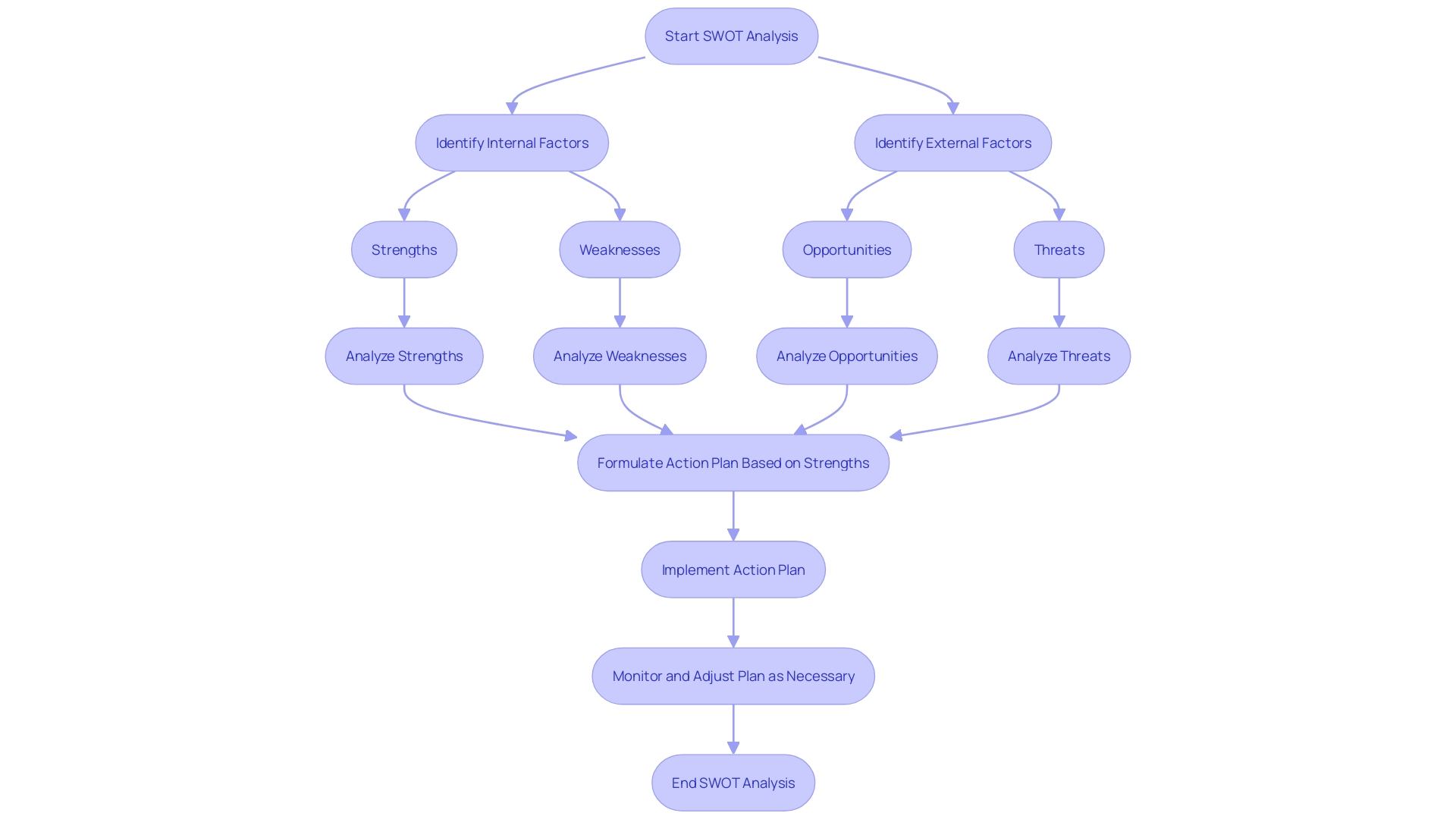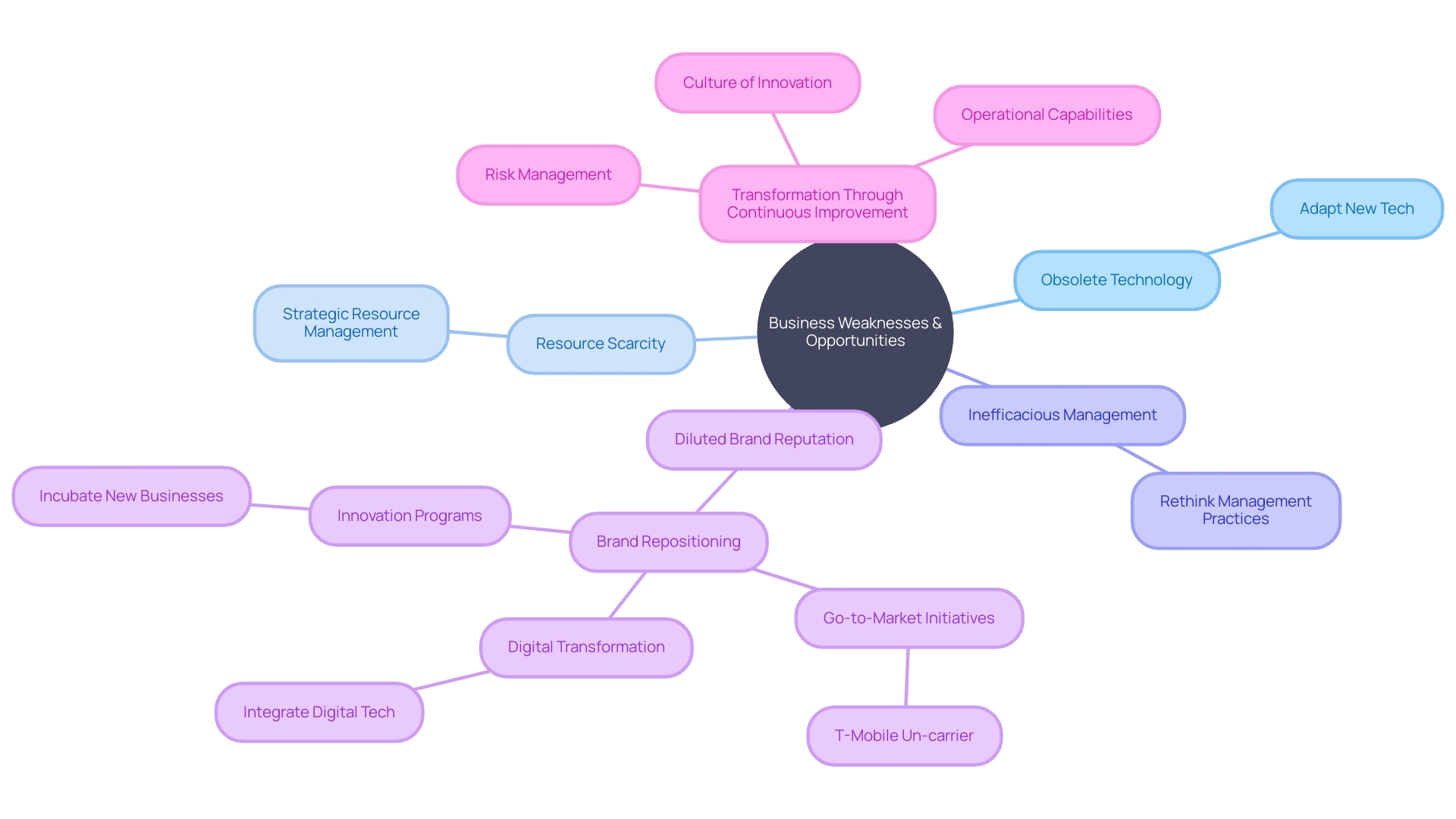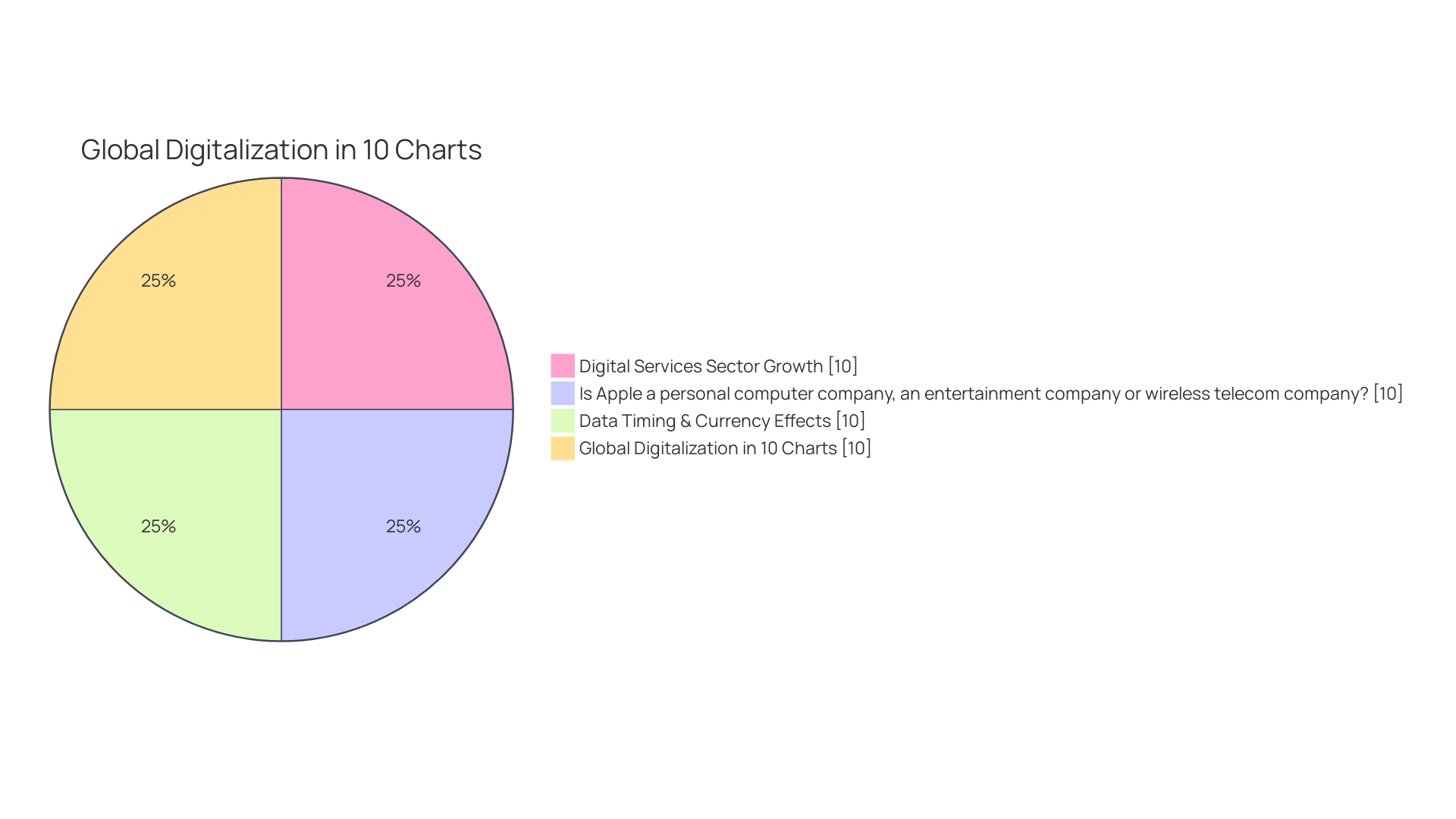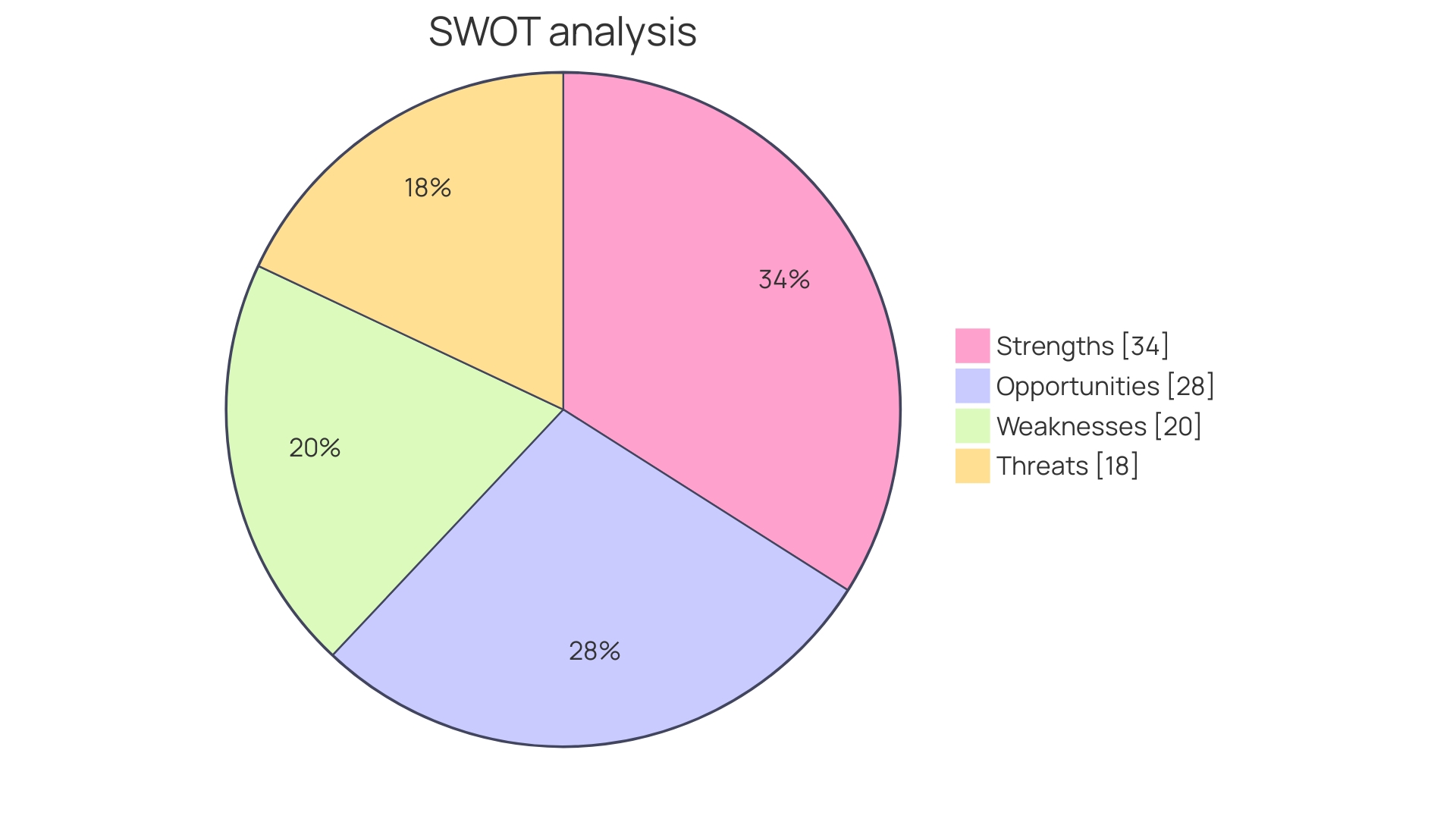Introduction
Are you a CFO looking to strengthen your company's market position and tackle prevailing challenges? If so, conducting a SWOT analysis can be a valuable strategic tool for you. This analysis provides a pragmatic structure for scrutinizing your company's internal dynamics and external conditions.
By identifying your strengths, weaknesses, opportunities, and threats, you can shape your future path with a keen awareness of your competitive landscape. In this article, we will explore the importance of a SWOT analysis, key questions to ask, how to conduct one effectively, and provide examples and best practices for your success. Get ready to gain valuable insights and navigate your industry confidently with a well-executed SWOT analysis.
What is a SWOT Analysis?
A SWOT analysis offers a pragmatic structure for scrutinizing a company's internal dynamics - such as its standout qualities and potential weak points - alongside external conditions, encompassing prospects and possible challenges. Performing this analysis guides businesses in shaping their future paths with a keen awareness of their competitive landscape and industry positioning.
For an organization to thrive, recognizing and leveraging internal strengths proves vital. These could manifest in various forms, including a skilled workforce, robust financial reserves, or advanced technological infrastructure – each contributing significantly to the organization's edge in the marketplace. Weaknesses, in contrast, require identification and strategic management to prevent them from undermining business achievements.
External factors hold equal importance. Opportunities present avenues for growth and improvement, which an organization must seize strategically. On the other hand, threats, often uncontrollable, like economic upheavals or shifting market trends, demand a proactive approach to mitigate potential detriments.
Incorporating insights from SWOT analyses enables organizations to devise robust strategies that capitalize on their strengths, remedy weaknesses, seize opportunities, and ward off threats. This strategic clarity is especially crucial in today's dynamic business environments, providing a valuable perspective for informed decision-making and long-term success.
Why Conduct a SWOT Analysis?
Harnessing the strategic power of SWOT analysis is crucial for companies seeking to fortify their market position, amplify their strengths, and tackle prevailing challenges. By shedding light on competitive advantages, this analytical framework guides businesses in sculpting robust strategies that meld their internal proficiencies with external prospects. Moreover, it empowers organizations to preemptively discern and adapt to dynamic market forces, regulatory shifts, and emerging threats.
Whether it's leveraging a unique technology or tapping into a skilled workforce, a SWOT analysis crystallizes these assets, enabling businesses to navigate their industry landscape confidently and craft concrete action plans aimed at sustainable growth and resilience.
Key SWOT Analysis Questions
A SWOT analysis serves as a fundamental framework in strategic planning, enabling organizations to identify both supportive and detrimental elements impacting their business. Essential to this analysis is asking the right questions to meticulously discern the internal strengths and weaknesses, alongside the external opportunities and threats that shape an organization's strategic direction. Engage in this evaluation to crystallize an action plan that effectively harnesses internal competencies and addresses potential vulnerabilities.
Diving into a SWOT analysis? Consider these critical queries:
- What distinguishes our company within the industry?
- Where do we perceive gaps or areas for improvement?
- Which market conditions present actionable opportunities?
- What external factors could jeopardize our market position or growth?
- In what ways can our inherent strengths catapult us towards new prospects?
- How can we fortify our weak spots to shield against external risks?
Responses to these inquiries guide companies in formulating strategies that play to their strengths and shore up weaknesses, all while nimbly navigating the opportunities and pitfalls within their commercial landscape. When your business contemplates its yearly objectives or prepares for a specific project, deploying a SWOT analysis as a structured, strategic tool will yield insights that inform a robust blueprint for the future. This clarity is vital whether you're weathering unforeseeable challenges, such as a global pandemic, escalating costs, intensifying competition, or a labor shortage.
How to Conduct a SWOT Analysis
Embarking on a SWOT analysis empowers organizations to spotlight their core competencies and the challenges they face. This analysis dissects internal factors defining your competitive edge, such as proprietary technology, a skilled workforce, and financial robustness. Conversely, it scrutinizes challenges you may encounter, such as technological obsolescence or resource deficits.
Externally, it encourages exploration of the landscape for potential growth avenues—emerging market trends or shifts in consumer needs. Moreover, it alerts to external dangers, notably competitive threats or regulatory changes.
Formulating a cohesive action plan demands thoughtful evaluation of these elements to bolster your strategic decisions. As per experts' endorsement of the tool, SWOT analysis is widely acclaimed for giving a holistic view of the business environment, enabling companies to devise strategies that utilize their strengths and navigate weaknesses, while capitalizing on opportunities and sidestepping threats. Focused on the actionable, it pivots you towards forward momentum in your industry, distinguishing your organization within its competitive sphere, particularly in aspects like workforce competency, financial health, and advanced technology tools.
With this approach, you'll recalibrate your organization's trajectory with precision, aligning it with long-term sustainable growth and resilience.

Strengths
Understanding your firm's unique capabilities is a cornerstone of devising a robust business strategy. These innate competencies, such as Travel Charme Hotels & Resorts’ potent blend of a family-friendly atmosphere and technological savvy, empower an organization to step ahead of the competition. As we’ve seen in their scenario, technology played a crucial role in optimizing hotel operations, which is indicative of leveraging strengths to streamline processes.
Moreover, startups often benefit from agility and the capacity to undertake ventures that established entities may bypass. Their success hinges on a willingness to embrace opportunities that provide a satisfactory return on investment after thorough evaluation. As per a compelling startup strategy, the decision to innovate or expand measures against the potential revenue against costs and the associated risks.
Staying consistent and effective in user experiences, as demonstrated by a technical selection of Django, Tailwind, and HTMX for one such startup, further showcases the significance of identifying and applying core strengths strategically. These technological choices alongside a keen SEO strategy, that scrutinizes competitor's traffic for optimization, represent strategic advantages in today’s digital domain.
In the broader business landscape, strategic assets like intellectual property, data, and access to distribution networks form the backbone of a company's competitive arsenal. A strong brand, healthy cash flow, an innovation-friendly culture, strategic partnerships, and requisite technology are among the nine strategic aspects critical for breakthrough success, as gleaned from over 200 substantial ventures.
Pondering on the unique strengths relevant to a variety of business contexts enable firms to undertake an introspective assessment. It's about identifying general business proficiencies and cultivating them or seeking external assistance to overcome any weaknesses, thus aligning them strategically for business success.
Analyses conducted on family-owned businesses and scaling startups alike underscore this concept. Family businesses, which significantly contribute to global GDP, exemplify resilience and endurance, often owing to their deep-rooted strategic strengths. For high-growth tech companies, harnessing the power of accumulated knowledge, despite the organizational strain from rapid expansion, is a testament to recognizing and scaling based on their unique capacities.
Hence, in a tumultuous business environment, a firm grasp of one’s organizational strengths—not merely in terms of product benefits but in the context of customer impact and co-created value—crucially fortifies long-term customer relationships and organizational prosperity.
Weaknesses
Interrogating the soft spots within a business's fabric is an enlightening exercise for shrewd management teams. For instance, a renowned hotel discovered its in-city-center location wasn't enough to elevate its food and beverage revenue. The solution: a savvy use of its prime location to tap into the passerby market, resulting in critical acclaim and a direct impact on sales.
This underscores the necessity for companies to identify their vulnerabilities, such as obsolete technology, resource scarcity, inefficacious management structures, or diluted brand reputation, with the aim to formulize rejuvenating strategies.
It might seem like a daunting task, but by embracing a culture of continuous improvement, companies can refine their operational capabilities. The case of IBL, operating across diverse sectors, demonstrates the significance of nurturing a balanced portfolio of innovative ideas as a defensive and offensive strategy against the unpredictable environment accentuated by the pandemic and socioeconomic tremors.
Indeed, as the YouGov PR calendar exemplifies the precision in campaign planning, so too should businesses apply meticulousness in addressing weaknesses. The precept is clear: harness the power of comprehensive assessments and strategic takings to not just mend the weak links, but to transform them into potential market advantages. After all, the rise of a national living wage and tackling societal issues such as period poverty can shift market dynamics, which businesses must be prepared to adapt to with agility and tenacity.

Opportunities
External opportunities present catalysts for the strategic growth and success of businesses by capitalizing on developing trends and evolutions in the market environment. Among these, the emergence and growth of new market territories are of paramount importance. For instance, as countries within the ambit of emerging markets experience a surge in industrialization and economic reform, corporations can harness these dynamics to expand their reach and profitability.
Notably, the youthful and expanding populations, along with the burgeoning middle classes in these territories, signal fresh consumer bases and avenues for deployment of innovative technological solutions.
In realms of technology, entities that craft strategic relationships in technological advancements can plant themselves firmly at the forefront of innovation. Taking a cue from early movers in online services, such as Talabat with its pioneering online food delivery platform, companies can leverage technological ingenuity to carve out significant market share before contemporaries.
Similarly, in the sphere of consumer behaviors, observing shifts in spending patterns and preferences, especially in economies with increasing disposable incomes, paves the way for personalized offerings and market infiltration. For example, Bemol, by addressing the unique logistical challenges of the Amazon region and providing indispensable connectivity solutions, exemplifies how businesses can turn potential obstacles into strategic victories.
Global interconnectivity further accentuates the importance of networking, particularly for new ventures seeking investors, partners, and customer engagement within and across emerging markets. According to entrepreneur James Dyson, the crux of thriving business leadership lies in the efficacy of networking and the subsequent pursuit of those established connections.
The significance of such external opportunities is underscored by statistics indicating that, since the early 2000s, emerging markets have expanded at an average rate of approximately 4–5% annually, outshining developed economies. This robust pace confirms the potential held within these markets for companies to exploit, elevating their growth trajectories. Furthermore, dividend yields from companies like Infosys, which link investors to emerging markets' vigorous growth, exemplify the financial inducements that entice and reward venture into these economically vibrant geographies.
Recognizing and adeptly pivoting to capitalize on these opportunities can equip businesses with the competitive leverage necessary to achieve heightened growth and success in the ever-evolving global marketplace.

Threats
In the shifting landscape where external forces can drastically influence a company's trajectory, vigilant attention to potential threats is paramount. Such threats encapsulate increasing competition, economic shifts, changes in regulatory landscapes, and disruptive technological advancements. A proactive approach involves acknowledging these threats to strategically devise resilient contingency measures.
For example, the hospitality industry is an arena where rivalry has evolved beyond conventional amenities to encompass the imperative, such as top-tier WI-Fi service, vital for both guest satisfaction and operational effectiveness. Global leader IHG Hotels & Resorts exemplifies proactive defense by transitioning to a managed software-defined wide area network (SD-WAN) from Fortinet. This technological upgrade not only fortifies against cyber threats but also optimizes communication between various hotel systems, potentially saving significant costs via network management efficiencies and negating the need for additional security personnel.
Businesses should take heed from IHG's endeavor, which underscores the necessity for high-level security architecture to maintain operational standards and customer trust. By integrating advanced security solutions, IHG achieved both cost-effectiveness and robust protection, a testament to the value of a holistic approach to potential threats. According to Security System News, within the next year, 46% of companies surveyed expressed intent to increase physical security budgets, reflecting the growing prioritization of safeguarding against external risks.
These instances point toward a broader trend within the security landscape, driven by an aggregate movement towards intelligent systems and cloud technologies, allowing for comprehensive threat perception and quicker resolution of security protocols. Businesses across various sectors would be well-advised to observe the rising trend in smart security offerings, which harness AI capabilities, offering prospective investments in AI-powered surveillance in the forthcoming five years by 42% of survey respondents. The era of intelligent security systems beckons, challenging companies to remain vigilant and adaptive in a world where external threats loom larger, and preparedness can make the difference between flourishing and faltering in the competitive arena.
Examples of SWOT Analysis
Consider the valuable insights from SWOT analyses of two distinct businesses:
- Business A has established a formidable brand identity and is powered by a talented workforce, which are considerable strengths. However, it faces high production costs and its market reach is somewhat limited. The expanding market appetite and the possibility of penetrating new segments present a ripe opportunity. Nonetheless, pronounced competition and shifts in consumer preferences pose credible threats.
- Business B is recognized for its inventive product range coupled with an effective supply chain, marking its key strengths. Yet, constraints like the lack of widespread brand recognition and reliance on a sole supplier remain as weaknesses. Monumental opportunities lie in going global and crafting strategic alliances, whereas economic unpredictability and potential supply chain hiccups stand as looming threats.
In implementing SWOT analysis, these businesses can identify their standpoints within their industries and devise strategies that play to their strengths while addressing weaknesses and adeptly navigating external influences.
A notable industry insight reveals that an estimated 40% of the workforce may require reskilling in the coming years due to AI and automation advancements. Additionally, climate change is increasingly influencing supply chains, encouraging businesses to set ambitious sustainability goals to reach net-zero emissions across their value chains by 2030.
Moreover, applications like Swarm demonstrate innovative uses of technology, providing comprehensive control over household energy consumption—a crucial step in the volatile energy landscape.
A SWOT analysis emerges as an indispensable planning tool that aids in capitalizing on robust organizational attributes and tackling weaknesses, all while efficiently responding to environmental factors. Understanding these dynamics helps businesses calibrate their strategies for steadfast progress and resilience in an ever-evolving corporate landscape.

Common Mistakes in SWOT Analysis
Avoiding pitfalls in SWOT analysis is pivotal for businesses to remain agile and competitive. One such pitfall is the lack of objectivity, often fueling analysis grounded in bias rather than facts. For precision, maintaining impartiality throughout the process is non-negotiable.
Equally important is the meticulous gathering of comprehensive data. An informed SWOT analysis pivots on rigorous research, collating granular details that accurately reflect the organization's context and industry’s landscape.
Moreover, organizations may inadvertently undervalue minor factors. Yet, it's these nuanced details that sometimes evolve into key influencers affecting business trajectory. Remaining acutely attuned to these elements is, therefore, essential.
Periodicity in SWOT analysis is another crucial discipline. As the business environment is in constant flux, propelled by variables such as market trends and regulatory shifts, an up-to-date analysis is fundamental for strategies that truly resonate with the current climate.
Embracing these best practices ensures that a SWOT analysis will not just be a cursory glance at an organization's standing, but a dynamic blueprint informing strategic direction, with the robustness to weather both internal weaknesses and external threats while harnessing untapped opportunities and strengths.
Best Practices for Effective SWOT Analysis
Executing a SWOT analysis with precision is paramount for organizations looking to navigate their industry landscape effectively. Engaging a variety of stakeholders across different specialties infuses the process with multifaceted insights, critical to uncovering the true internal dynamics and external pressures. Meanwhile, anchoring this analysis in solid, current data ensures the conclusions derived are both valid and actionable.
To distill the essence of your business's strategic positioning, the SWOT exercise should be succinct, homing in on the pivotal elements that will drive the most impactful decisions. Harnessing the insights gained, decision-makers must then sculpt concrete plans that translate analysis into dynamic action, exploiting strengths and addressing vulnerabilities.
Recognizing that market conditions and internal capabilities are not static, revisiting and fine-tuning the SWOT analysis regularly is an indispensable practice. This continuous reflection ensures strategies remain aligned with the evolving business ecosystem, propelling the organization towards its desired trajectory while maintaining responsiveness to unpredictable obstacles such as economic shifts, competitive activity, or workforce dynamics.
In essence, a well-conducted SWOT analysis serves not just as a snapshot of current conditions but as a perpetual compass guiding strategic decisions, making it an indispensable tool for project managers and stakeholders seeking to steer their initiatives toward success.
Conclusion
In conclusion, conducting a SWOT analysis is crucial for CFOs seeking to strengthen their company's market position and tackle challenges. It provides a pragmatic structure to scrutinize internal dynamics and external conditions, shaping future paths and highlighting competitive advantages.
A well-executed SWOT analysis empowers CFOs to identify strengths, weaknesses, opportunities, and threats. This analysis informs decision-making and guides the development of robust strategies that leverage internal proficiencies, address weaknesses, seize opportunities, and mitigate threats.
Key questions drive an effective SWOT analysis, helping CFOs identify what sets their company apart, where improvements can be made, actionable opportunities, and potential risks. This evaluation informs strategies that play to strengths, address weaknesses, and navigate the commercial landscape.
Recognizing and leveraging unique capabilities is essential for devising a robust business strategy. By understanding strengths like a strong brand or innovation, companies can stand out in the competitive arena. Addressing weaknesses and embracing external opportunities, such as emerging markets or strategic alliances, further drives growth and success.
Avoiding common mistakes, such as lack of objectivity or overlooking minor factors, ensures the accuracy of the analysis. Engaging stakeholders, anchoring the analysis in current data, and periodic review are vital for effective SWOT analysis.
In summary, a well-executed SWOT analysis helps CFOs gain insights, make informed decisions, and navigate the industry landscape. By leveraging strengths, addressing weaknesses, seizing opportunities, and mitigating threats, CFOs strengthen their market position and achieve long-term success.




